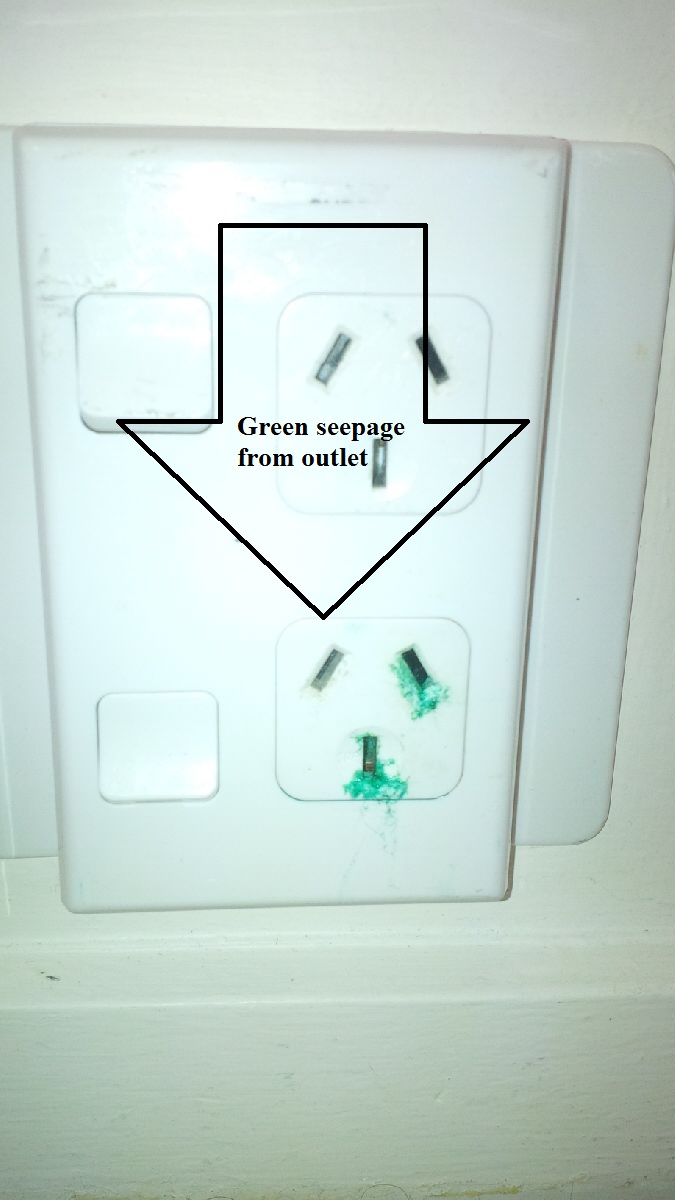Green gunge (also known as green goo, slime or exudate) maybe seen coming out of the ends of older PVC insulated and sheathed cables installed in the 1960's and 70's.
The the plasticiser that was used to provide flexibility in the PVC polymer compound (di-octyl phthalate) over time or with heat reacts with the copper conductors to produce copper phthalate (causing the green colour).
The material does not present a health concern but should be handled with care – gloves should be used and waste disposed of properly. There does not appear to be a problem with the electrical performance or safety of the cable itself but any exuded goo should be removed as it can cause corrosion and will affect the action of switches and terminations.
The cables should be replaced when insulation tests reveal failure or when cracking of the insulation becomes apparent.
It is suggested on some web sites that in some cases, such as behind light switches or socket outlets, the amount of exudate can be reduced by forming a drip loop in the cables below the terminal. This is incorrect, the exudate uses the cable cores as a pipe line and drips from the end of the cable wether the cable is up or down.
The removal of the exudate is important as it not only causes corrosion in the copper or other metal components, it also catalyses further degradation of the PVC and more of the PVC polymer release so that the whole process can "run away with itself".
Eventually the cable insulation becomes brittle and subject to mechanical failure - low elongation at break, which is why City Electricians recommends replacement f the cable when reported.
Although it is likely to mean a hit in one's pocket, the only really safe option is a rewire - wiping or cleaning the green gloop should only be a temporary fix sorting out the symptom but not the cause.
 "Green gunge" (also known as green goo, slime or exudate) is the green liquid that may be seen coming out of the ends of older PVC insulated and sheathed cables installed in the 1960's and 70's.
"Green gunge" (also known as green goo, slime or exudate) is the green liquid that may be seen coming out of the ends of older PVC insulated and sheathed cables installed in the 1960's and 70's.
The liquid is the plasticiser that was used to provide flexibility in the PVC polymer compound (di-octyl phthalate) leaches over time and, with heat, reacts with the copper conductors to produce copper phthalate (causing the green colour).
The material does not present a health concern but should be handled with care,contact with eyes and skin can cause irritation – gloves should be used and waste disposed of properly. There does not appear to be a problem with the electrical performance or safety of the cable itself but any exuded goo should be removed as it can cause corrosion and will cause the action of switches and terminations to be degraded or completely stop working. It can also cause high resistant joints which can lead to overheating and fire.
The cables should be replaced when insulation tests reveal failure or when cracking of the insulation becomes apparent.
It is suggested on some web sites that the amount of exudate can be reduced by forming a drip loop in the cables below the terminals behind light switches and socket outlets. This is incorrect, the exudate uses the cable cores as a pipe line and drips from the end of the cable whether the cable is up or down.
The removal of the exudate is important as it not only causes corrosion in the copper or other metal components, it also catalyses further degradation of the PVC. More of the PVC polymer releases so that the whole process can "run away with itself".
Eventually the cable insulation becomes brittle and subject to mechanical failure which is why City Electricians recommends replacement of the cable when reported.
Although it is likely to mean a hit in your pocket, the only really safe option is a rewire - wiping or cleaning the green goo should only be a temporary fix sorting out the symptom but not the cause.
 "Green gunge" (also known as green goo, slime or exudate) is the green liquid that may be seen coming out of the ends of older PVC insulated and sheathed cables installed in the 1960's and 70's.
"Green gunge" (also known as green goo, slime or exudate) is the green liquid that may be seen coming out of the ends of older PVC insulated and sheathed cables installed in the 1960's and 70's.  "Green gunge" (also known as green goo, slime or exudate) is the green liquid that may be seen coming out of the ends of older PVC insulated and sheathed cables installed in the 1960's and 70's.
"Green gunge" (also known as green goo, slime or exudate) is the green liquid that may be seen coming out of the ends of older PVC insulated and sheathed cables installed in the 1960's and 70's.